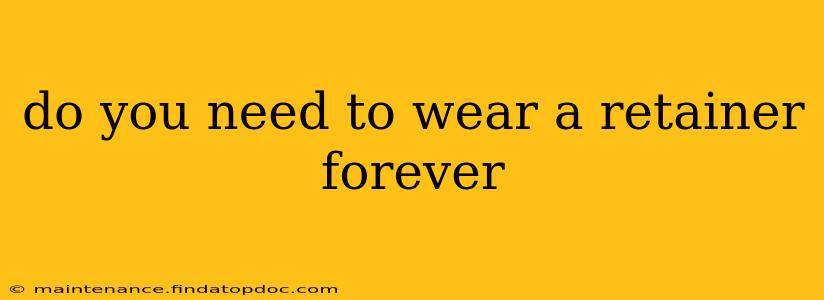Many people who've undergone orthodontic treatment, like braces or Invisalign, wonder about the lifelong commitment to retainers. The short answer is: it depends. While you won't necessarily need to wear a retainer forever in the strictest sense, lifelong retainer use is often recommended to maintain the straight, healthy smile you worked so hard to achieve. Let's delve deeper into this crucial aspect of orthodontic aftercare.
How Long Do You Typically Need to Wear a Retainer?
The duration of retainer wear varies significantly depending on several factors. Your orthodontist will create a personalized plan based on your individual needs and the complexity of your treatment. Generally, you'll start with full-time retainer use (22-24 hours a day) for several months to a year. After this initial phase, your orthodontist may recommend transitioning to nighttime-only wear or a reduced schedule. Some individuals might only require retainer use for a few years, while others may benefit from wearing them indefinitely.
What Factors Influence Retainer Wear Time?
Several factors influence how long you'll need to wear a retainer:
-
Severity of the initial misalignment: More severe cases often require longer retainer use to prevent teeth from shifting back to their original positions.
-
Age: Younger patients' jaws are still growing and developing, potentially requiring longer retainer use to stabilize the teeth and accommodate these changes.
-
Compliance: Consistently wearing your retainer as prescribed by your orthodontist is crucial. Inconsistent use can lead to relapse and necessitate a longer overall retainer wearing period.
-
Type of retainer: Different retainer types offer varying levels of retention. Fixed retainers (bonded to the back of your teeth) provide more robust stabilization and may require less long-term wear compared to removable retainers.
What Happens if You Stop Wearing Your Retainer Too Soon?
Stopping retainer use prematurely can lead to several issues:
-
Teeth Shifting: Your teeth might gradually shift back towards their original positions, negating the results of your orthodontic treatment.
-
Crowding: Teeth can become crowded again, affecting your bite and potentially leading to discomfort and further orthodontic issues.
-
Relapse: This is the term for the teeth reverting to their pre-treatment position. A complete relapse might necessitate further orthodontic treatment.
What are the Different Types of Retainers?
Understanding the different types of retainers helps clarify the duration of wear:
-
Removable Retainers: These are typically made of plastic or wire and can be removed for cleaning and eating. They often require longer-term wear to maintain stability.
-
Fixed Retainers: These are bonded to the back of your teeth and are permanently cemented in place. They provide excellent retention but can't be removed for cleaning and might require adjustments over time.
Can You Wear a Retainer for Too Long?
While unlikely to cause direct harm, wearing a retainer for an excessively long period might lead to discomfort or irritation. Regular checkups with your orthodontist are essential to assess the need for continued retainer use and make any necessary adjustments.
How Often Should I See My Orthodontist After Treatment?
Your orthodontist will provide a schedule for follow-up appointments. These checkups are crucial to monitor the position of your teeth, assess the health of your gums and bite, and determine whether continued retainer use is necessary. Following their recommendations is key to maintaining a healthy and straight smile.
In conclusion, while there's no definitive "forever" answer, the goal of retainer use is long-term maintenance of your improved smile. Your orthodontist's guidance is essential in determining the ideal duration for your specific situation. Consistent communication and adherence to their recommendations are vital for achieving lasting results.
